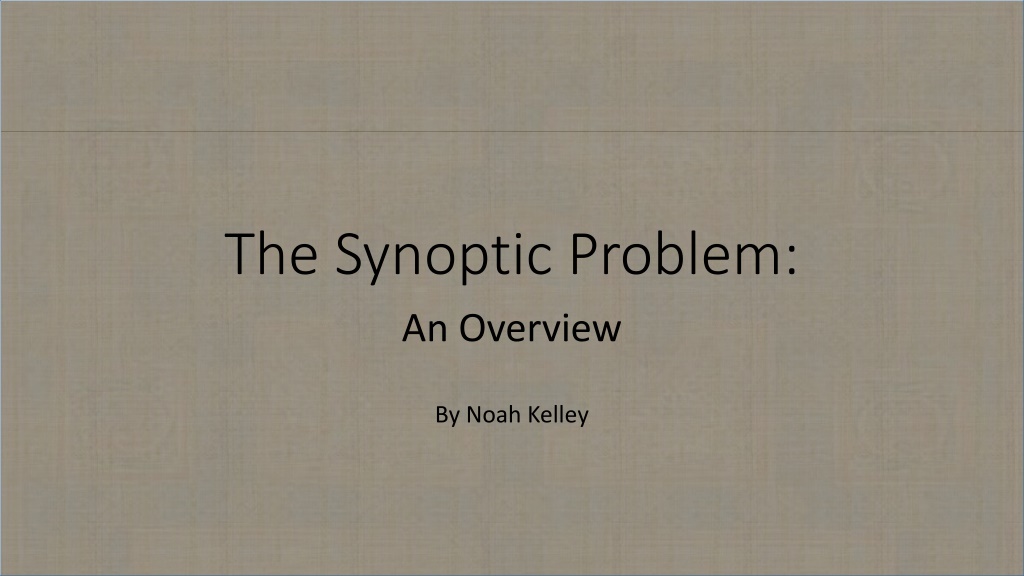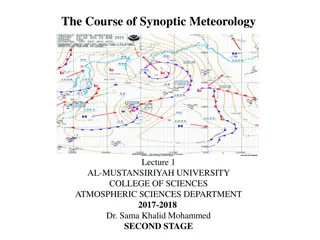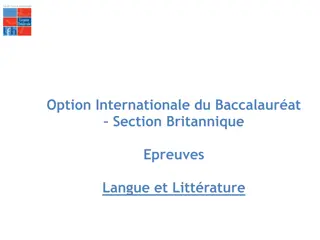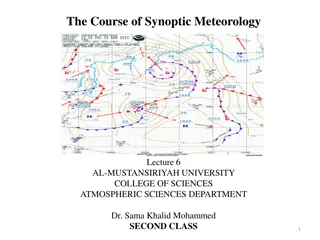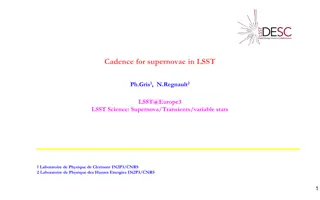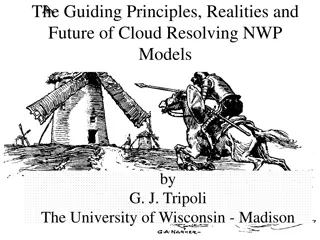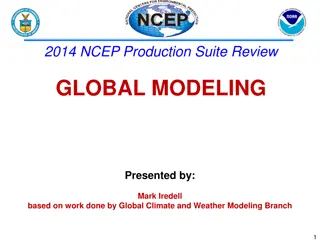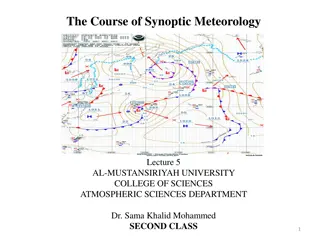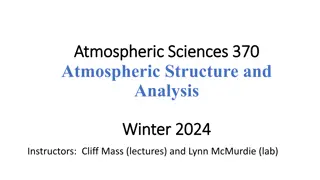The Synoptic Problem:
The Synoptic Problem delves into similarities and differences among the first three Gospels—Matthew, Mark, and Luke—unveiling diverse proposed solutions from Patristic views to German Scholarship analysis. Questions arise regarding the order of writing, Hebrew versions, and canonical sequencing, offering intriguing insights into the origins of these biblical texts.
Download Presentation

Please find below an Image/Link to download the presentation.
The content on the website is provided AS IS for your information and personal use only. It may not be sold, licensed, or shared on other websites without obtaining consent from the author.If you encounter any issues during the download, it is possible that the publisher has removed the file from their server.
You are allowed to download the files provided on this website for personal or commercial use, subject to the condition that they are used lawfully. All files are the property of their respective owners.
The content on the website is provided AS IS for your information and personal use only. It may not be sold, licensed, or shared on other websites without obtaining consent from the author.
E N D
Presentation Transcript
The Synoptic Problem: An Overview By Noah Kelley
I. Introduction The Synoptic Problem (SP) defined: The SP is the question regarding the reason behind the similarities and differences between the first three gospels as it relates to their origins
I. Introduction Similarities and differences exist with regard to: 1. Wording 2. Order of events 3. Parenthetical material 4. OT quotations
Matthew Mark Luke I. Introduction Matthew and Mark Matthew and Luke All three Mark and Luke Matt 12:1 Mark 2:23 , Luke 6:1 , . 2 . .
I. Introduction Matthew Mark Luke The Calming of a Storm (8:23 27) (4:35 41) (8:22 25) The Healing of the Gadarene Demoniacs (8:28 34) The Healing of a Paralytic (9:1 8) (5:1 20) (8:26 39) The Healing of a Paralytic (2:1 12) The Healing of a Paralytic (5:17 26) The Calling of Matthew (9:9 13) The Calling of Levi (2:13 17) The Calling of Levi (5:27 32) The Question about Fasting (9:14 17) The question about Fasting (2:18 22) The Question about Fasting (5:33 39) (12:1 8) Plucking grain on the Sabbath (2:23 28) The Man with a Withered Hand (3:1 6) The Man with a Withered Hand (6:6 Plucking Grain on the Sabbath (6:1 5) (12:9 14) 11) A Multitude at the Seaside (3:7 12) Section Titles and parallels from UBS5 headings
II. Proposed Solutions: Patristic views There is a consistent tradition that places Matthew s gospel first in time of writing. There is some question about a Hebrew version of Matthew, or whether what Matthew composed was a sayings source. The content of Mark s Gospel is consistently attributed to Peter There is some question about the order of Mark and Luke. Clement of Alexandria said that the Gospels with genealogies were composed before those without. However, Augustine believed that they were written in canonical order, as does the Anti-Marcionite Prologue to Luke and Origen (according to Eusebius CH 6.25.3 6). Augustine s view of the canonical order being the chronological order became the dominant view in the medieval church.
II. Proposed Solutions: German Scholarship J. J. Griesbach (1745 1812): first used a synopsis to analyze the synoptics. Held to Matthean priority K. Lachmann (1793 1851): examined the order of events in the synoptics and proposed that Mark was earlier and closer to a primitive source on which all relied. C. H. Weisse (1801 1866): held to a similar view as Lachmann, but added that Matthew and Luke must have shared a sayings document. H. J. Holtzmann (1832 1910): held the standard two document view, presented it thoroughly.
II. Proposed Solutions: British Scholarship John Hawkins: produced a detailed study on the synoptic gospels titled Horae Synopticae: Contributions to the Study of the Synoptic Problem (2nd ed. 1909). William Sanday (1843 1920): chaired the Oxford Seminar on the Synoptic Problem (1894ff) B. H. Streeter (1874 1937): developed the four document theory. This is a complicated version of the two document theory. The four documents are: 1) Mark, 2) Q, 3) L, 4) M L + Q = proto-Luke + Mark = Luke Mark + Q + M = Matthew B. C. Butler: wrote The Originality of St. Matthew (1951), in which he pointed out that the argument from order is inconclusive.
II. Proposed Solutions: Questioning Q A. Farrer: wrote On Dispensing with Q (1957) M. Goulder: argued in Midrash and Lection in Matthew (1969 71) that Matthew used Mark but no Q
II. Proposed Solutions: Revival of the Two- Gospel hypothesis W. Farmer (1921 2000): wrote The Synoptic Problem: A Critical Analysis (1964). J. B. Orchard: produced a Gospel Synopsis based on the two Gospel view (1983) D. L. Dungan: wrote the book AHistory of the Synoptic Problem (1999).
II. Proposed Solutions: Typology of Theories: Common dependence on Aramaic original (G. E. Lessing; expanded by J. G. Eichhorn) Oral sources (Herder; Geiseler; Westcott) Gospel fragments (F. Schleiermacher) Literary independence (R. Thomas, E. Linnemann, D. Farnell; Gerhardsson, Riesner) Literary dependence Augustinian view Matthean Priority Various versions of Markan priority
III. Three Popular Solutions: 1. Independence Proponents: Theologically based Independence View (R. Thomas, E. Linnemann, D. Farnell) Independence View based on memory and orality (Riesner, B. Gerhardsson)
III. Three Popular Solutions: 1. Independence Arguments: theologically based Independence View Negative Arguments: Higher critical methods are inherently hostile to the Word. Those who practice them are failing to be obedient to God by separating from error and exposing the unorthodox. Dependency is assumed and not proven. (Farnell, The Independence View )
III. Three Popular Solutions: 1. Independence Arguments: theologically based Independence View Positive Arguments: The independence view was the only view until the Enlightenment. Other explanations are possible (memorization of material, the historicity of events, common tradition) Orthodox presuppositions demand it: The gospel writers were eyewitnesses The inspiration of the Scriptures by the Holy Spirit means that the Gospels are qualitatively unique in comparison to all other documents. (Farnell, The Independence View )
III. Three Popular Solutions: 1. Independence Problems: Commits the genetic fallacy Ad hominem attacks Confusion of issues (e.g. wrongly assumes that literary dependence views = low view of Scripture) The interpretation of the Fathers is inaccurate
III. Three Popular Solutions: 1. Independence Conclusion: The willingness to engage with the fathers and consider other possibilities is commendable, as is the defense of Scripture The use of fallacious reasoning and ad hominem attacks, in addition to some confusion of issues is problematic
III. Three Popular Solutions: 1. Independence Arguments for the Memorized Material view The disciples used rabbinic methods, especially memorization, for catechetical material. This explains the synoptic phenomena.
III. Three Popular Solutions: 1. Independence Arguments for the Memorized Material view The disciples used rabbinic methods, especially memorization, for catechetical material. This explains the synoptic phenomena. Problems: Do we have evidence that the early Christians followed rabbinic methods? Is this an explanation sufficient for all the synoptic phenomena?
III. Three Popular Solutions: 1. Independence Conclusion: Needs more investigation, but not likely an exclusive explanation
III. Three Popular Solutions: 2. Markan Priority Proponents: C. H. Weisse, H. J. Holtzmann, B. H. Streeter, R. Stein, S. McKnight Varieties: 1. Markan priority 2. Two Document (or Two Source) view 3. Four Document view 4. Farrar-Goulder
III. Three Popular Solutions: 2. Markan Priority Arguments: almost exclusively based on internal evidence Mt and Lk seldom agree against Mk, but Mk tends to be in the majority. Mk s Greek is less refined Mk is the shortest, but the pericopes are longer. About 90% of Mark is reproduced in Mt, and 50% is reproduced in Lk Given Mk, it is easy to understand why we have Mt and Lk, but given Mt and Lk, it is not easy to see why Mk was needed. Furthermore, why would Mk set out to condense Mt and Lk by editing out portions, but then lengthen individual pericopes? Mk has more difficult readings (theologically) Mark 6:5 6 = Matt 13:58
III. Three Popular Solutions: 2. Markan Priority Mark 6:5 6 , . 6 . Matt 13:58 .
III. Three Popular Solutions: 2. Markan Priority Arguments: almost exclusively based on internal evidence Various internal phenomena are better explained on the basis of Markan priority than Matthean priority: Stylistic features of Mk shared by Mt in places where Markan material is present. Mark uses ( immediately ) 41 times. Matthew uses is 18 times, 14 of which are found in material shared with Mark. Mark uses editorial 34 times. Matthew uses it 10 times, and all are within shared material.
III. Three Popular Solutions: 2. Markan Priority Arguments: almost exclusively based on internal evidence Various internal phenomena are better explained on the basis of Markan priority than Matthean priority: Matthew s OT quotations If Mark depended on Matthew, why would he select only those quotations with a text- form relatively close to the standard versions of the Septuagint? (Blomberg, 23) Mk has various Aramaic expression that are absent in Mt and Lk (Mk 3:17; 5:41; 7:11, 34; 14:36; 15:22, 34)
III. Three Popular Solutions: 2. Markan Priority Arguments: almost exclusively based on internal evidence Various internal phenomena are better explained on the basis of Markan priority than Matthean priority: Redaction: Mt and Lk s adaptations of Mark can often be explained on the basis of their distinct emphases, while it becomes more difficult to explain why Mk would remove distinctively Matthean or Lukan material. Matthew s use of Son of David (12:23; 15:22; 21:9, 15) Matthew s use of this was to fulfill (1:22; 2:15, 17; 4:14; 8:17; 12:17; 13:14, 35; 21:4; 27:9)
III. Three Popular Solutions: Excursus on Q Reasons for Q: There is material common to both Mt and Lk that is not found in Mk. It consists mostly of Jesus s teaching. Common wording extends to unusual words and phrases and grammatical peculiarities. These materials have been placed in different contexts by Mt and Lk Some of this material may be in a roughly similar order The existence of so-called doublets in Mt and Lk, suggesting that one occurrence derives from Mk and the other from another source (Q)
III. Three Popular Solutions: Excursus on Q Problems with Q: We have never found any evidence for its existence outside of the similarities between Mt and Lk If Matthew was first, Q disappears Perhaps Q is no more than a convenient symbol for the material common to Mt and Lk and lacking in Mk (Guthrie, 161).
III. Three Popular Solutions: 2. Markan Priority Problems with Markan priority: Many of the internal evidences can be explained in other ways Lack of consideration for church history The need for hypothetical documents (such as Q)
III. Three Popular Solutions: 2. Markan Priority Problems with Markan priority: Minor agreements These are yet unexplained agreements between Mt and Lk that do not derive from Mk This is the biggest argument against the two source theory Minor agreements are explained in numerous ways by proponents of the two source view, however, none of these solutions have yet dispelled this objection. Some examples are: Mark and Q overlap Both Mt and Lk redacted Mk in coincidentally identical ways Textual corruption that has caused harmonization in the gospels
III. Three Popular Solutions: 2. Markan Priority Problems with Markan priority: Minor agreements Some examples of the most significant agreements (Stein, Studying, 134- 136): Matt 3:11 12 = Mark 1:7 8 = Luke 3:16 18 Matt 9:7 8 = Mark 2:12 = Luke 5:25 26 Matt 26:67 68 = Mark 14:65 = Luke 22:63 65 cf. also Mark 3:24, 26 29; 5:27; 6:33; 9:2, 10; 14:72
III. Three Popular Solutions: 2. Markan Priority Matt 3:11 12 Mark 1:7 8 Luke 3:16 17 * , . 8 16 * , , , , .
III. Three Popular Solutions: 2. Markan Priority Matt 3:11 12 Mark 1:7 8 Luke 3:16 17 12 , . 17 , .
III. Three Popular Solutions: 2. Markan Priority Conclusion: The greatest strength of Markan priority is the internal evidence: When one assumes Markan priority, coherent patterns of redactional emphases emerge in ways that are not true on alternative models (Blomberg, 20). The greatest weaknesses are its lack of engagement with church history and the minor agreements between Mt and Lk.
III. Three Popular Solutions: 3. Matthean Priority (AKA, the Two Gospel Hypothesis or the Griesbach Hypothesis) Proponents: J. J. Griesbach, F. C. Baur and the T bingen School, W. Farmer, J. B. Orchard, D. L. Dungan, B. C. Butler, D. A. Black
III. Three Popular Solutions: 3. Matthean Priority Arguments: based on external evidence and the shortcomings of Markan priority Church history favors Matthean priority There is a consistent tradition that places Matthew s gospel first in time of writing. The content of Mark s Gospel is consistently attributed to Peter, while Mark is said to be his recorder or translator. Clement of Alexandria is reported by Eusebius (Church History 6.25.3 6) to have said that the Gospels with genealogies were composed before those without.
III. Three Popular Solutions: 3. Matthean Priority Arguments: based on external evidence and the shortcomings of Markan priority The minor agreements between Matthew and Luke favor Matthean priority Markan redundancies seem to indicate that Mark conflates both Matthew and Luke No need for Hypothetical documents (such as Q)
III. Three Popular Solutions: 3. Matthean Priority Problems: There is some question about a Hebrew version of Matthew (Irenaeus, in Eusebius, Church History 5.8.1-4) could mean in their own language or in their own style (See also Papias in Church History 3.39.15-16). Origen says that it was written in ( Hebrew characters or letters; see Eusebius, Church History 6.25.3-6). Augustine seems to say likewise (De consensu evangelistarum 1.3-4) Note also debate about whether Matthew composed a sayings source (cf. Eusebius Church History 39.3.15-16).
III. Three Popular Solutions: 3. Matthean Priority Problems: There is disagreement over whether Mark or Luke came after Matthew. Clement said that the Gospels with genealogies were composed before those without Augustine believed that they were written in canonical order, as does the Anti- Marcionite Prologue to Luke and possibly Origen (according to Eusebius CH 6.25.3 6) and others.
III. Three Popular Solutions: 3. Matthean Priority Problems: Compelling explanations of the internal evidence can be given based on Markan priority Markan redundancies seem to be a part of his style rather than a conflation of Mt and Lk Questions about the scribal mechanics implied in the production of Mark from a Matthean view (cf. Richards, Paul and First-Century Letter Writing) Are we sure that Mark could take shorthand? How does taking shorthand relate to the data of the text? If Peter zig-zagged from one document to another for different pericopes, this should imply that each pericope is either Matthean-based or Lukan-based. We should not expect to find them combined. Is this what we find?
III. Three Popular Solutions: 3. Matthean Priority Conclusion: The strength of Matthean priority is its engagement with church history (external evidence) and the weaknesses of Markan priority, which are more adequately explained, in some cases, by Matthean Priority The weakness of Matthean priority is that it often makes less sense when looking at the internal evidence
Excursus: The Synoptic Problem and inerrancy 1. The SP can provide a challenge to our view of inerrancy because of some of the differences between the accounts 2. We must distinguish between truth and precision 3. An ipsissima voxview of the author s task strains the evidence less than an approach that harmonizes every account 4. The narratives are not less than history, but they are more than history 5. The authors indicate the significance of the events by their shaping of them. 6. This is a good thing and not a problem to explain away
IV. Conclusion 1. There does seem to be a literary dependence 2. Mark is clearly the middle term 3. The strength of the Matthean priority position is the use of church history and the shortcomings of the Markan priority position 4. The Strength of the Markan priority is the plausibility based on internal evidence 5. Remaining questions: 1. What impact might the question of memorized material have on the SP? 2. What impact might the study of scribal practices have on the SP? 3. How likely is it that we have all of the information that is needed to provide an answer to the SP? 4. Are the major solutions offered at this point procrustean ?
Bibliography Baird, William. History of New Testament Research, Vol. 3. Black, David Alan. Why Four Gospels? _____, and David R. Beck, eds. Rethinking the Synoptic Problem. Carson and Moo, Introduction to the New Testament. Goodacre, Mark. The Synoptic Problem: A Way through the Maze. Guthrie, Donald. New Testament Introduction. K stenberger, Kellum, and Quarles. The Cradle, the Cross, and the Crown. Niell and Wright, The Interpretation of the New Testament 1861-1986. Stein, Robert. Studying the Synoptic Gospels: Origin and Interpretation. _____. Synoptic Problem, in Dictionary of Jesus and the Gospels. Thomas, Robert L. Historical Criticism and the Evangelical: Another View. _____, ed. Three Views on the Origins of the Synoptic Gospels. Porter and Dyer, eds. The Synoptic Problem: Four Views.
